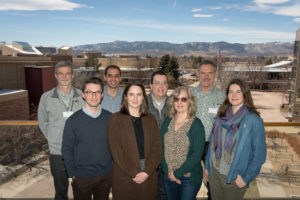In the dark
Study reveals need for better understanding effects of light pollution on migrating animals story by Jayme DeLoss photos and video courtesy of Kyle Horton and Carolyn Burt published Jan. 9, 2023As certain species of animals follow their instinct to migrate, some become disoriented by the glow from urban areas and wander off route, where far too many meet their fates. A recent study by a transdisciplinary research team found ample evidence of the negative effects of light pollution on migrating animals but also areas where we’re still in the dark in our understanding.
The study’s team, which includes ecologists and political scientists from Colorado State University’s Warner College of Natural Resources and the University of Oklahoma, concluded that there’s a need for more data to help protect migrating animals. Their research is published in Trends in Ecology and Evolution and was funded by a $3 million National Science Foundation grant, with $1.5 million awarded to CSU.
The scientists reviewed studies on light pollution and animal migration from the past five years and determined that more research needs to be done on all species, but particularly species other than birds, which dominate the existing research. Light pollution also harms bats, butterflies, moths and grasshoppers, for example.
All the migratory animals studied to date were negatively impacted by light pollution. When birds are drawn off course, they are at risk of fatally colliding with buildings, especially structures with lots of large windows. But scientists still don’t understand the underlying processes that short-circuit normal migration patterns.
“We don’t understand mechanistically why animals are attracted to light and why it’s such a problem,” said Carolyn Burt, who is the convergence coordinator for the NSF grant and first author on the study. “We need more data at the local, regional and macro scales for all migratory species.”
The team will use the study’s results to guide their ongoing research. They are working to improve ecological forecasting through BirdCast, a tool developed by the Cornell Lab of Ornithology, CSU and the University of Massachusetts that provides daily migration forecasts.
“By more accurately predicting when nocturnally migrating birds are moving through specific areas, we hope to give better information to stakeholders running lights-out campaigns in cities across the country,” said Kyle Horton, BirdCast principal investigator, senior author on the study, and assistant professor of fish, wildlife and conservation biology.
New pathways for conservation

A key component of the team’s research is exploring the human side of the problem. Last summer, they conducted a national survey, the first of its kind, to gain baseline knowledge of the public’s perception of the issue.
“Hopefully by pairing our research with those data and new information from the survey, we can better implement new policies and recommendations,” Burt said.
The researchers have collaborated with 10 federal agencies and nongovernmental organizations from the start to ensure the type of information collected will be useful.
Social science is an important piece of this research, said Jeff Kelly, a biology professor at the University of Oklahoma and co-author on the study. He said the team’s community partners are ready to act, and the survey results will give them direction on how to move forward to enact positive change.
“How do you engage with people in a way that they understand the effects of lights on their health but also on ecosystems, and then reach a sustainable solution without creating a polarized environment in which you have people who are seen as winners and losers?” Kelly said. “In our view, there isn’t a loser. It’s just that we get used to certain kinds of lighting conditions, and then we see those as normal and accept the negative consequences without evaluating them.”
Unlike many environmental problems, there’s a seemingly simple solution to light pollution: turning off the lights – which would benefit biodiversity and human health.
“Of course, it’s much more complex with the sociopolitical issues,” Burt said. She said a transdisciplinary approach is necessary to address a societal problem like light pollution.
“Taking a transdisciplinary approach allows us to more wholly address both the ecological and social science aspects of light pollution by examining improved ecological forecasting, understanding the political landscape, and more broadly engaging with stakeholders and the public,” Burt said.